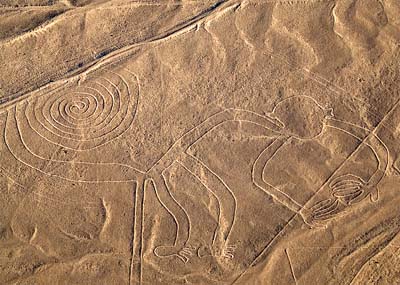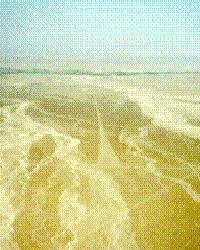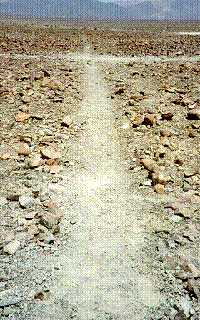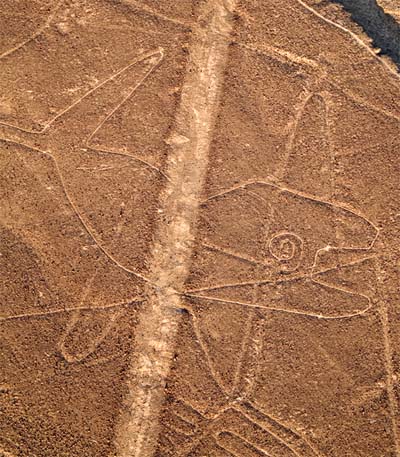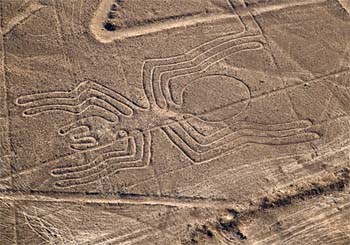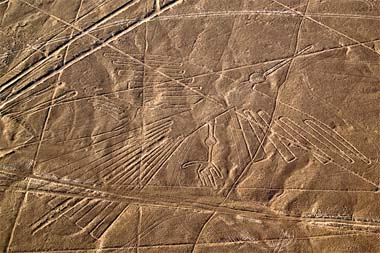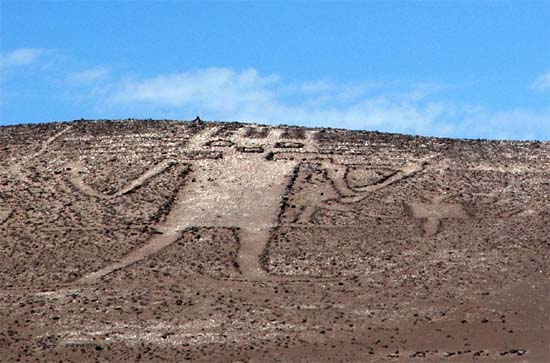pop up description layer
HOME
Cryptozoology UFO Mysteries Aviation Space & Time Dinosaurs Geology Archaeology Exploration 7 Wonders Surprising Science Troubled History Library Laboratory Attic Theater Store Index/Site Map Cyclorama
Search the Site: |
|
The Lines of Nazca Peru
In the Peruvian Desert, about 200 miles south of Lima, there lies a plain between the Inca and Nazca (sometimes also spelled Nasca) Valleys. Across this plain, in an area measuring 37 miles long and 1-mile wide, is an assortment of perfectly-straight lines, many running parallel, others intersecting, forming a grand geometric form. In and around the lines there are also trapezoidal zones, strange symbols, and pictures of birds and beasts all etched on a giant scale that can only be appreciated from the sky. The figures come in two types: biomorphs and geoglyphs. The biomorphs are some 70 animal and plant figures that include a spider, hummingbird, monkey and a 1,000-foot-long pelican. The biomorphs are grouped together in one area on the plain. Some archaeologists believe they were constructed around 200 BC, about 500 years before the geoglyphs. There are about 900 geoglyphs on the plain. Geoglyphs are geometric forms that include straight lines, triangles, spirals, circles and trapezoids. They are enormous in size. The longest straight line goes nine miles across the plain.
Discovery and Meaning Though discovered by Peruvian archaeologist Toribio Mejia Xesspe who spotted them while hiking through the surrounding foothills in 1927, the forms are so difficult to see from the ground that they were not widely known until the 1930's when aircraft spotted them while surveying for water. The plain, crisscrossed, by these giant lines with many forming rectangles, has a striking resemblance to a modern airport. The Swiss writer, Erich von Daniken, even suggested they had been built for the convenience of ancient visitors from space to land their ships. As tempting as it might be to subscribe to this theory, the desert floor at Nazca is soft earth and loose stone, not tarmac, and would not support the landing wheels of either an aircraft or a flying saucer. So why are the lines there? The American explorer Paul Kosok, who made his first visit to Nazca in the 1940s, suggested that the lines were astronomically significant and that the plain acted as a giant observatory. He called them "the largest astronomy book in the world." Gerald Hawkins, an American astronomer, tested this theory in 1968 by feeding the position of a sample of lines into a computer and having a program calculate how many lines coincided with an important astronomical event. Hawkins showed the number of lines that were astronomically significant were only about the same number that would be the result of pure chance. This makes it seem unlikely Nazca is an observatory.
Perhaps the best theory for the lines and symbols belongs to Tony Morrison, the English explorer. By researching the old folk ways of the people of the Andes mountains, Morrison discovered a tradition of wayside shrines linked by straight pathways. The faithful would move from shrine to shrine praying and meditating. Often the shrine was as simple as a small pile of stones. Morrison suggests that the lines at Nazca were similar in purpose and on a vast scale. The symbols may have also served as special enclosures for religious ceremonies. Construction of the Lines How were they built? The lines were apparently made by brushing away the reddish, iron oxide covered pebbles that compose the desert surface and uncovering the white colored sand underneath. In most places wind, rain and erosion would quickly remove all traces of this within a few years. At Nazca, though, the lines have been preserved because it is such a windless, dry and isolated location. A writer by the name of Jim Woodman believes that the lines and figures could not have been made without somebody in the air to direct the operations. "You simply can't see anything from ground level," states Woodman. "You can't appreciate any of it from anywhere except from above. You can't tell me the Nazca builders would have gone to the monumental efforts they did without ever being able to see it." Woodman has proposed that ancient hot-air balloons were used to get an aerial view of the construction. To prove his hypothesis, Woodman constructed a balloon using materials that would have been available to the Nazca people. He was able to conduct a successful flight, though it only lasted two minutes.
Most researchers are extremely skeptical of Woodman's conclusions, however, as they find little evidence in the remains left by the Nazca of any balloon construction or operation. It is more likely that the Nazca people used simple surveying techniques in their work. Straight lines can be made easily for great distances with simple tools. Two wooden stakes placed as a straight line would be used to guide the placement of a third stake along the line. One person would sight along the first two stakes and instruct a second person in the placement of the new stake. This could be repeated as many times as needed to make an almost perfectly-straight line miles in length. Evidence that the line makers used this technique exists in the form of the remains of a few stakes found at the ends of some of the lines. The symbols were probably made by drawing the desired figure at some reasonable size, then using a grid system to divide it up. The symbol could then be redrawn at full scale by recreating the grid on the ground and working on each individual square one at a time. Related to Water? Recently two researchers, David Johnson and Steve Mabee, have advanced a theory that the geoglyphs may be related to water. The Nazca plain is one of the driest places on Earth, getting less than one inch of rain a year. Johnson, while looking for sources of water in the region, noticed that ancient aqueducts, called puquios, seemed to be connected with some of the lines. Johnson thinks that the shapes may be a giant map of the underground water sources traced on the land. Mabee is working to gather evidence that might confirm this theory.
Other scientists are more skeptical, but admit that in a region where finding water was vital to survival, there might well be some connection between the ceremonial purpose of the lines and water. Johan Reinhard, a cultural anthropologist with the National Geographic Society, found that villagers in Bolivia walk along a straight pathway to shrines while praying and dancing for rain. Something similar may have been done at the ancient Nazca lines. Human Sacrifice A recently discovered headless body suggests that human sacrifice was used by the Nazca people in religion ceremonies. "Human sacrifice and decapitation were part of powerful rituals that would have allayed fears by invoking the ancestors to ensure fertility and the continuation of Nasca society," wrote Christina Conlee of Texas State University in an article in Current Anthropology. "The decapitation of the La Tiza individual appears to have been part of a ritual associated with ensuring agricultural fertility and the continuation of life and rebirth of the community." The body is one of eight found in the Nazca area, buried seated with no head. A ceramic jar painted with an image of a head was found next to the remains. The head on the jar has a tree with eyes growing out of it, making it seem likely that the sacrifice was part of a fertility ceremony.
What was done with the heads of the victims? The Nazca were known to collect "Trophy Heads." The Nazca removed the brain and soft tissue from the skulls, sewed the lips closed with cactus spines and drilled a hole through the forehead to accommodate a loop of woven rope. The heads were then hung on the ropes for display. Originally these were considered to be war trophies collected from distant tribes, but recent DNA analysis shows that the heads came from the Nazca population itself, suggesting that the motive was religious in nature. Other South American Lines and Figures The lines at Nazca aren't the only landscape figures South America boasts. About 850 miles south of the plain is the largest human figure in the world laid out upon the side of Solitary Mountain in Chile. The Giant of Atacama stands 393 feet high and is surrounded by lines similar to those at Nazca. Along the Pacific Coast in the foothills of the Andes Mountains is etched a figure resembling a giant candelabrum. Further south, Sierra Pintada, which means "the painted mountain" in Spanish, is covered with vast pictures including spirals, circles, warriors and a condor. Archaeologists speculate that these figures, clearly visible from the ground, served as guideposts for Inca traders.
Copyright Lee Krystek 1997-2010. All Rights Reserved. |
|
Related Links |
|
|



